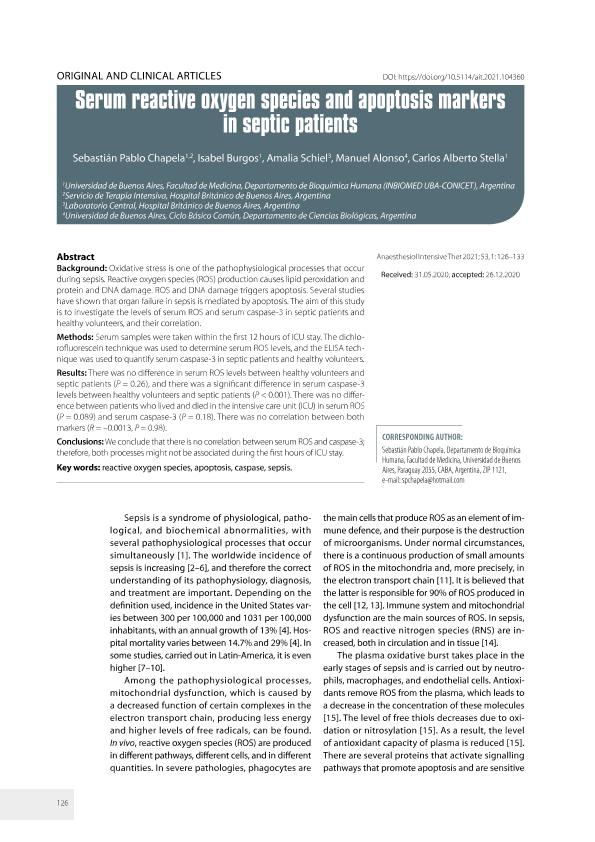Mostrar el registro sencillo del ítem
dc.contributor.author
Chapela, Sebastián Pablo

dc.contributor.author
Burgos, Hilda Isabel

dc.contributor.author
Schiel, Amalia
dc.contributor.author
Alonso, Manuel
dc.contributor.author
Stella, Carlos Alberto

dc.date.available
2021-10-05T14:47:18Z
dc.date.issued
2020-12
dc.identifier.citation
Chapela, Sebastián Pablo; Burgos, Hilda Isabel; Schiel, Amalia; Alonso, Manuel; Stella, Carlos Alberto; Serum reactive oxygen species and apoptosis markers in septic patients; Termedia Publishing House Ltd; Anaesthesiology Intensive Therapy; 53; 2; 12-2020; 126-133
dc.identifier.issn
1642-5758
dc.identifier.uri
http://hdl.handle.net/11336/142681
dc.description.abstract
Background: Oxidative stress is one of the pathophysiological processes that occur during sepsis. Reactive oxygen species (ROS) production causes lipid peroxidation and protein and DNA damage. ROS and DNA damage triggers apoptosis. Several studies have shown that organ failure in sepsis is mediated by apoptosis. The aim of this study is to investigate the levels of serum ROS and serum caspase-3 in septic patients and healthy volunteers, and their correlation. Methods: Serum samples were taken within the first 12 hours of ICU stay. The dichlorofluorescein technique was used to determine serum ROS levels, and the ELISA technique was used to quantify serum caspase-3 in septic patients and healthy volunteers. Results: There was no difference in serum ROS levels between healthy volunteers and septic patients (P = 0.26), and there was a significant difference in serum caspase-3 levels between healthy volunteers and septic patients (P < 0.001). There was no difference between patients who lived and died in the intensive care unit (ICU) in serum ROS (P = 0.089) and serum caspase-3 (P = 0.18). There was no correlation between both markers (R =-0.0013, P = 0.98). Conclusions: We conclude that there is no correlation between serum ROS and caspase-3; therefore, both processes might not be associated during the first hours of ICU stay.
dc.format
application/pdf
dc.language.iso
eng
dc.publisher
Termedia Publishing House Ltd

dc.rights
info:eu-repo/semantics/openAccess
dc.rights.uri
https://creativecommons.org/licenses/by-nc-sa/2.5/ar/
dc.subject
APOPTOSIS
dc.subject
CASPASE
dc.subject
REACTIVE OXYGEN SPECIES
dc.subject
SEPSIS
dc.subject.classification
Otras Ciencias de la Salud

dc.subject.classification
Ciencias de la Salud

dc.subject.classification
CIENCIAS MÉDICAS Y DE LA SALUD

dc.title
Serum reactive oxygen species and apoptosis markers in septic patients
dc.type
info:eu-repo/semantics/article
dc.type
info:ar-repo/semantics/artículo
dc.type
info:eu-repo/semantics/publishedVersion
dc.date.updated
2021-09-17T16:45:35Z
dc.identifier.eissn
1731-2531
dc.journal.volume
53
dc.journal.number
2
dc.journal.pagination
126-133
dc.journal.pais
Poland
dc.description.fil
Fil: Chapela, Sebastián Pablo. Hospital Británico de Buenos Aires; Argentina. Consejo Nacional de Investigaciones Científicas y Técnicas. Oficina de Coordinación Administrativa Houssay. Instituto de Investigaciones Biomédicas. Universidad de Buenos Aires. Facultad de Medicina. Instituto de Investigaciones Biomédicas; Argentina
dc.description.fil
Fil: Burgos, Hilda Isabel. Consejo Nacional de Investigaciones Científicas y Técnicas. Oficina de Coordinación Administrativa Houssay. Instituto de Investigaciones Biomédicas. Universidad de Buenos Aires. Facultad de Medicina. Instituto de Investigaciones Biomédicas; Argentina
dc.description.fil
Fil: Schiel, Amalia. Hospital Británico de Buenos Aires; Argentina
dc.description.fil
Fil: Alonso, Manuel. Universidad de Buenos Aires; Argentina
dc.description.fil
Fil: Stella, Carlos Alberto. Consejo Nacional de Investigaciones Científicas y Técnicas. Oficina de Coordinación Administrativa Houssay. Instituto de Investigaciones Biomédicas. Universidad de Buenos Aires. Facultad de Medicina. Instituto de Investigaciones Biomédicas; Argentina
dc.journal.title
Anaesthesiology Intensive Therapy
dc.relation.alternativeid
info:eu-repo/semantics/altIdentifier/doi/http://dx.doi.org/10.5114/ait.2021.104360
dc.relation.alternativeid
info:eu-repo/semantics/altIdentifier/url/https://www.termedia.pl/Serum-reactive-oxygen-species-and-apoptosis-markers-in-septic-patients,118,43495,1,1.html
Archivos asociados
